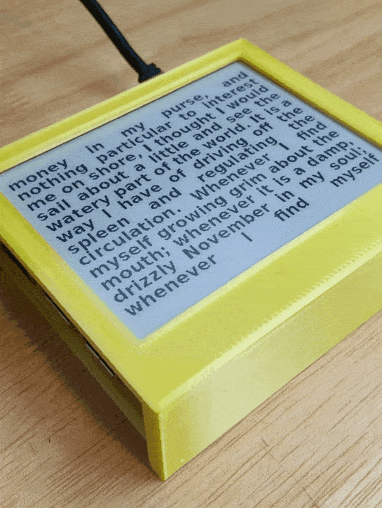Node.js library for easily creating an ePaper display on a Raspberry Pi using HTML and Javascript.
ePaper.js can be used as:
- A command line application for single step rendering of a URL onto an ePaper display
- A library that can interface ePaper displays with custom Node.js applications
Features include:
- Supports multiple ePaper Displays
- High performance, native c++ hardware access
- Multiple color modes: black / white, grayscale, black / white / red
- Dithering for black / white images
ejs <command> [options] <deviceType>
For example, the following command will update the Waveshare 7.5" v2 screen with the contents of http://localhost:8080 every 10 minutes.
ejs refresh rpi-7in5-v2 "http://localhost:8080"
For available devices types, see supported hardware. The different commands and suggested workflows are described below.
Display: display a single rendition of a URL
ejs display [options] <deviceType> <url>
| Option | Description | Allowed Values |
|---|---|---|
-o / --orientation |
Use (h)orizontal or (v)ertical orientation | [h, v] |
-c / --colorMode |
Desired color mode | [black, 4gray, red] |
--screenshotDelay |
Wait an additional amount of time after loading the URL before displaying. Useful for client side apps | Time in milliseconds |
--dither |
Use a dithering algorithm to approximate grayscale / mid-tones on black and white displays | |
--username |
Username for basic authentication | username as string |
--password |
Password for basic authentication | password as string |
--debug |
Print additional log info and stacktraces | |
--version |
Show version number | |
--help |
Show help |
Refresh: continuously update and display the URL
ejs refresh [options] <deviceType> <url>
| Option | Description | Allowed Values |
|---|---|---|
-i / --interval |
Amount of time between refreshes | Time in seconds (default 10 min) |
-o / --orientation |
Use (h)orizontal or (v)ertical orientation | [h, v] |
-c / --colorMode |
Desired color mode | [black, 4gray, red] |
--screenshotDelay |
Wait an additional amount of time after loading the URL before displaying. Useful for client side apps | Time in milliseconds |
--dither |
Use a dithering algorithm to approximate grayscale / mid-tones on black and white displays | |
--username |
Username for basic authentication | username as string |
--password |
Password for basic authentication | password as string |
--debug |
Print additional log info and stacktraces | |
--version |
Show version number | |
--help |
Show help |
Clear: clear the display
ejs clear [options] <deviceType>
| Option | Description | Allowed Values |
|---|---|---|
--debug |
Print additional log info and stacktraces | |
--version |
Show version number | |
--help |
Show help |
Self-Hosting
- Create a web app and store it on your Raspberry Pi
- Host the web app with http-server
- Run ePaper.js with
ejs refresh <deviceType> "http://localhost:8080" (or whatever port you configure http-server to run on)
Cloud Hosting
- Create a web app and host it on a service like GitHub Pages or Netlify
- Run ePaper.js with
ejs refresh <deviceType> "<URL of your app>"
Running As a Daemon
There are several methods of automatically launching ePaper.js on startup and restarting in case of failures
- Run with pm2
- Create a systemd service
See the examples directory
- weather-station: This creates an example weather station display
- color-test: Used to test the various color modes
- 4gray: A demonstration of the 4gray capabilities
- dithering: A demonstration of the dithering feature
The following versions are the recommended versions that using during development and testing. Other versions may work, but are not officially supported.
- Node.js:
16 LTS - Raspberry Pi OS:
Bullseye 32 / 64bit - Chromium:
104.0.5112.105
Enable SPI
sudo raspi-config
# Choose Interfacing Options -> SPI -> Yes to enable SPI interface
sudo rebootInstall Node The official recommendation by Node.js is to install Node with a package manager. This helps ensure you'll have the latest LTS version and the proper permissions to install global packages. ePaper.js recommends using nvm
Raspberry Pi 2, 3, 4 Zero 2:
curl -o- https://raw.githubusercontent.com/nvm-sh/nvm/v0.39.1/install.sh | bash
source ~/.bashrc
nvm install 16Raspberry Pi 1, Zero:
curl -o- https://raw.githubusercontent.com/nvm-sh/nvm/v0.39.1/install.sh | bash
source ~/.bashrc
NVM_NODEJS_ORG_MIRROR=https://unofficial-builds.nodejs.org/download/release
nvm install 16Install Dependencies
sudo apt-get update
sudo apt-get install -y build-essential chromium-browserInstall ePaper.js
Globally install the @epaperjs/cli command line app and the appropriate package for your screen (See supported hardware).
For example, to install ePaper.js for the Waveshare 7.5" V2 Screen:
npm install --global @epaperjs/cli @epaperjs/rpi-7in5-v2| Device | Device Type | npm Package | Color Modes |
|---|---|---|---|
| Waveshare 4.2" | rpi-4in2 |
@epaperjs/rpi-4in2 |
black 4gray |
| Waveshare 7.5" v2 | rpi-7in5-v2 |
@epaperjs/rpi-7in5-v2 |
black |
| Waveshare 3.7" hat | rpi-3in7 |
@epaperjs/rpi-3in7 |
black, 4gray |
| Waveshare 2.13" hat v2 | rpi-2in13-v2 |
@epaperjs/rpi-2in13-v2 |
black, red |
| Waveshare 2.13" bc | rpi-2in13-bc |
@epaperjs/rpi-2in13-bc |
black |
| Waveshare 2.7" | rpi-2in7 |
@epaperjs/rpi-2in7 |
black |
It's easy to extend ePaper.js to support additional Waveshare devices. Displays from other manufacturers should be possible to support as well, as long as there is a C / C++ driver available.
If you would like to request support for another display, please open an issue with the title 'Add support for <Device Make \ Model>'. If you're a developer and have extended support yourself, put up a pull request!


